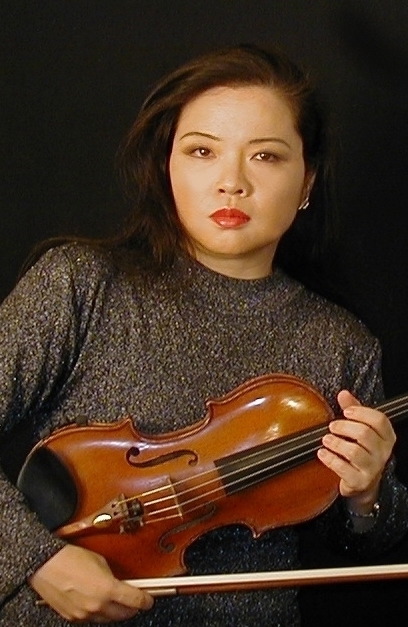Mari Kimura is a New York composer and virtuoso violinist whose music includes haunting low notes on the violin called sub-harmonics. . . Problem is, these sounds aren’t supposed to be possible.
The tones she plays are in the register of a cello, and usually cannot be made from a violin. Even she is stumped about how it works. I don’t really know what it is I do, she said, because she learned it by trial and error.
A team of scientists in Norway, is the latest to take a crack at the puzzle. Kimura has said that she has been making these sounds for more than ten years. She demonstrated her ability to top scientists in the US, but they gave up trying to find out how the effect happens.

Stringed instruments work by having a string being vibrated. The string is shortened or lengthened using the fingers. The shorter the string, the higher the pitch and vice-versa. Normally, you would not be able to make a pitch lower than the lowest note on an instrument because you can only shorten the string, not lengthen it. The sounds that Mari produces are of a pitch that requires a string longer than the strings on the violin.
She says: As an artist you are always searching for ways to expand the sound. Oh yes, in case you were wondering, there *is* an audio example. There are more examples of longer pieces on her site.
Mari has a really cool CD out where she combines her amazing technique with electronic elements. Check it out here .
**UPDATE** I’ve been in contact with Mari and the physicists studying her technique. I’ll be writing a followup to this article explaining it all, how she does it and the physics behind it.






I see two possibilities:
– some (wind) organs “fake” very deep bass notes by generating a set of harmonics (with real pipes); the ear-brain reconstructs the missing fundamental. A violin player should tell us if that’s possible on his instrument…
– it’s a studio scam (no offense intended, I just examine the _possibilities_): has somebody heard the lady playing live without a microphone?
I thought only the comments on CNN political forums had negative, pseudo-knowledgeable, argumentative content. Guess the trolls are everywhere.
I am surprised that it took so long for the anti-science folks to pipe up. Must be THA LAWD!
Wirewehear said
“Could be that a scientist isn’t always right.”
This is heresy, and I applaud you for it!
wow…the sound is soooo eerie. Thanks for posting, it’s quite interesting how this sound can be made, hoping to read some more of this article.
I haven’t read through the whole comment list yet, but there’s a couple of misconceptions that need a little clearing up.
The biggest one seems to be the confusion between a subharmonic and a combination tone. A subharmonic is an individually generated natural pitch that is lower in tone than the vibrating membrane (no jokes please). A combination tone is a pitch that is created by two separate tones summing together to create an audible tone at the sum point or difference point. A third form of pitch generation can involved rapidly played percussive elements where the speed at which the percussive sounds occur determine the perceived pitch. There is a famous harpsichord that demonstrates this effect (so famous I can’t remember what it’s called).
Another point of confusion seems to be that of sympathetic vibrations. A sympathetic vibration is when a sound vibrates a membrane with harmonically related length. In other words, if you strike the low A on a piano, the A on the next octave will vibrate as well. Through this, one can mute the low A, and from the remaining vibrating strings our ear may infer the fundamental tone (the low A), we do not actually hear that pitch.
A few people mentioned lightly touching a string instead of fretting it. This produces a harmonic tone – which is one octave above the fret point. Basically, it mutes the fundamental tone and allows the next harmonic up to be heard clearly.
Hearing a sound clip, I can also say that this is not a “wolf” tone either – which is the tone of the body resonance combining with the fundamental tone being played.
Lastly, there is mention of the bow itself producing the tone. Bow hair is drawn taught and coated in Rosin. What little vibrations would translate to the bow would die out in milliseconds.
Mari is an exceptionally skilled violinist, and an exciting composer. My only personal problem I have with this whole subharmonics thing is that it often becomes the focal point in discussing Mari – distracting from her music, and her compositional techniques.
Very interesting article and a great blog overall. I would like to track new posts from the blog, is there any way I can subscribe to that? Thank you, keep up the good work.
Could this be the same effect that happens when playing one note on a loud guitar and then, as you bend the next lower string up to the same pitch, you hear a corresponding lower pitch descending as the two higher pitches come together? Or on Blind Willie Johnson’s “Let it Shine”, halfway through his meek tenor is joined by an UNDERtone, an octave lower, as if an evil Jehovah was singing along as an ominous warning… fascinating, I’ve always wondered if all of these things were explainable in physics. Does anyone know yet? peas out, tubers in…
From her site, Mari Kimura gets to hang out with Max Matthews. Apparently he was sampling the sound. He is definitely a top scientist.
who are these “top scientists” in the US? Who are these scientists in Norway? Upon what do they (allegedly) base that this should not be possible?
Oh, and there’s now an update promising to explain “the physics behind it” so I guess the “mystery” has been solved, eh?
What a stupid, sensationalist post.
The technique boils down to basically ‘crunching’ the bow down, isn’t it?
There have been times where I’ve simulated bad violin playing and (in my case involuntary) ‘farts’ like that to accompany the sound of enthusiastic cat mating are not exactly rocket science to ‘play’ on the violin.
To do it in a controlled way is another skill you have to master though, kudos to her but methinks it’s not a huge mystery.
all of you “violinist” who are posting in here saying you can do this….GTFO
srsly you guys(and gals, I want to be an equal opportunity h8r) are bad
Wow, she is kinda cute!
Jiff
My real question is: Will it blend?
This effect is known in large church bells: the pitch you hear is lower than any of the actual frequencies being generated by the bell. What’s happening is that the actual frequencies are part of the overtone series for a fundamental that isn’t present, but you auditory system fills in and ‘hears’ the fundamental.
It’s well known in psychoacoustics that you can produce perceived pitches that don’t include the frequency being ‘heard’. Hope this is useful.
Maybe you mean “sound that are supposed to be impossible” in the title? You are negating the wrong thing!
Anyone else completely lose control of their bowels when they listed to the audio example?